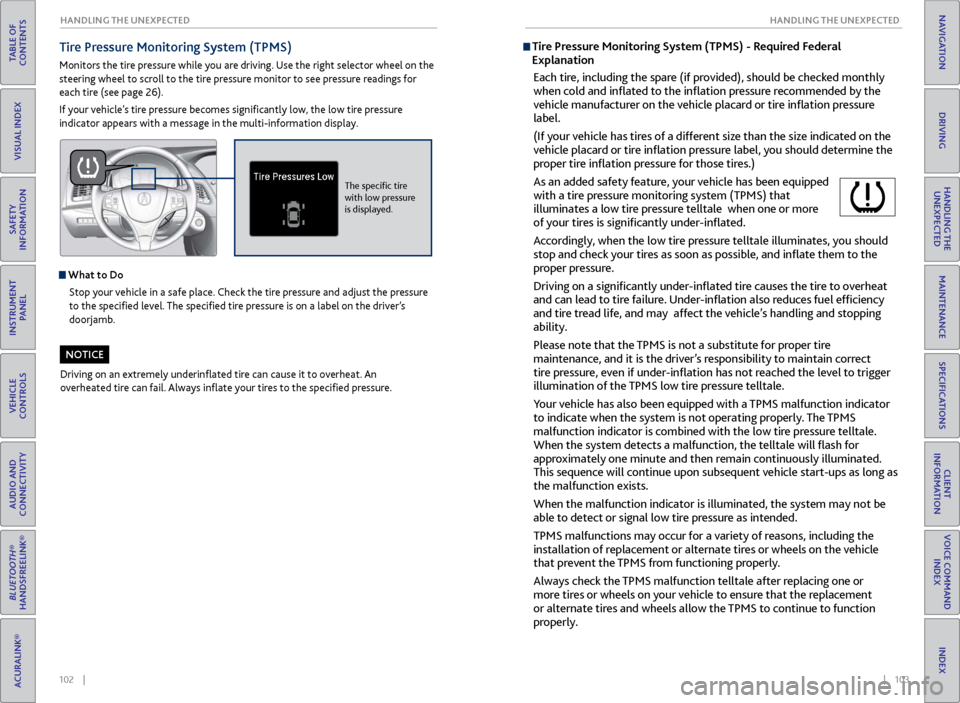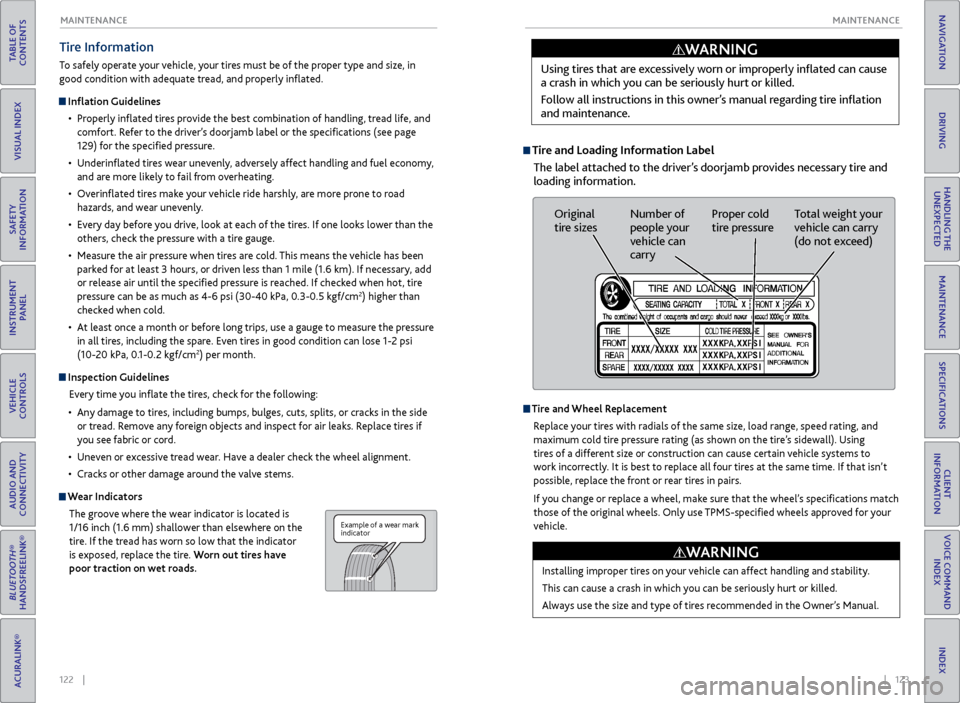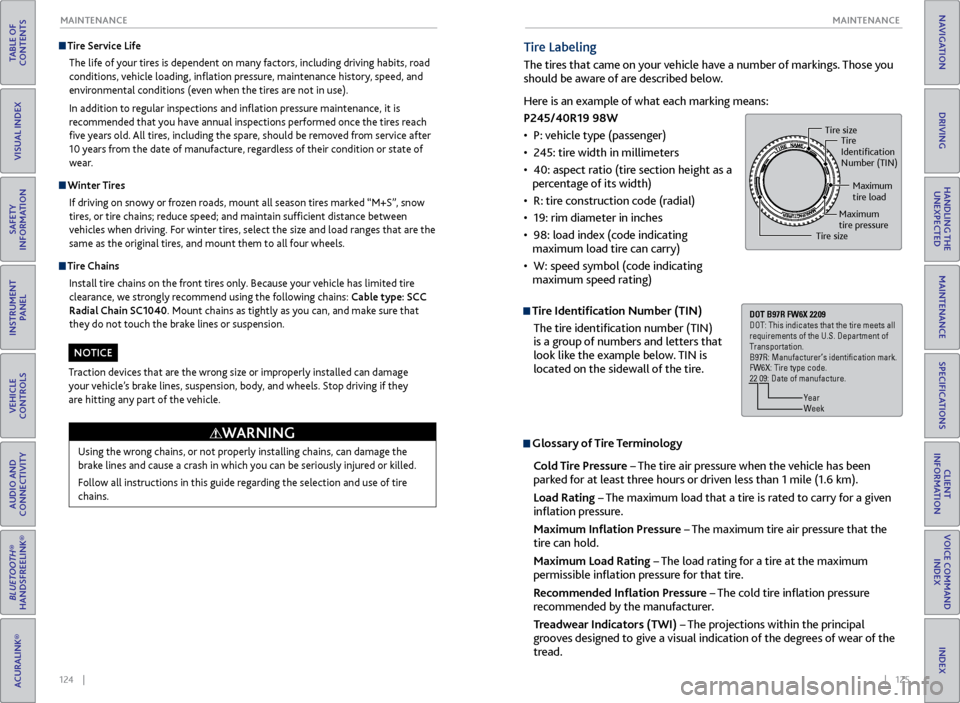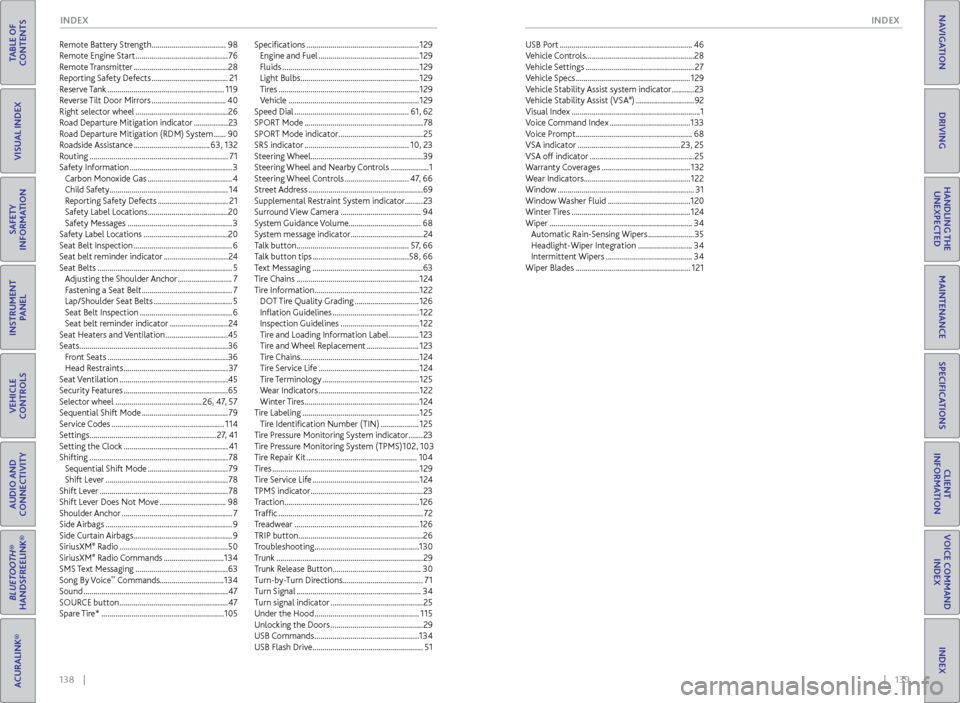inflation pressure Acura RLX 2017 Quick Guide
[x] Cancel search | Manufacturer: ACURA, Model Year: 2017, Model line: RLX, Model: Acura RLX 2017Pages: 73, PDF Size: 7.37 MB
Page 55 of 73

102 || 103
HANDLING THE UNEXPECTED
HANDLING THE UNEXPECTED
TABLE OF
CONTENTS
INDEX
VISUAL INDEX
VOICE COMMAND INDEX
SAFETY
INFORMATION
CLIENT
INFORMATION
INSTRUMENT PANEL
SPECIFICATIONS
VEHICLE
CONTROLS
MAINTENANCE
AUDIO AND
CONNECTIVITY
HANDLING THE UNEXPECTED
BLUETOOTH®
HANDSFREELINK®
DRIVING
ACURALINK®
NAVIGATION
Tire Pressure Monitoring System (TPMS)
Monitors the tire pressure while you are driving. Use the right selector wheel on the
steering wheel to scroll to the tire pressure monitor to see pressure readings for
each tire (see page 26).
If your vehicle’s tire pressure becomes significantly low, the low tire pressure
indicator appears with a message in the multi-information display.
What to Do
Stop your vehicle in a safe place. Check the tire pressure and adjust the pressure
to the specified level. The specified tire pressure is on a label on the driver’s
doorjamb.
Driving on an extremely underinflated tire can cause it to overheat. An
overheated tire can fail. Always inflate your tires to the specified pressure.
NOTICE
The specific tire
with low pressure
is displayed.
Tire Pressure Monitoring System (TPMS) - Required Federal
Explanation
Each tire, including the spare (if provided), should be checked monthly
when cold and inflated to the inflation pressure recommended by the
vehicle manufacturer on the vehicle placard or tire inflation pressure
label.
(If your vehicle has tires of a different size than the size indicated on the
vehicle placard or tire inflation pressure label, you should determine the
proper tire inflation pressure for those tires.)
As an added safety feature, your vehicle has been equipped
with a tire pressure monitoring system (TPMS) that
illuminates a low tire pressure telltale when one or more
of your tires is significantly under-inflated.
Accordingly, when the low tire pressure telltale illuminates, you should
stop and check your tires as soon as possible, and inflate them to the
proper pressure.
Driving on a significantly under-inflated tire causes the tire to overheat
and can lead to tire failure. Under-inflation also reduces fuel efficiency
and tire tread life, and may affect the vehicle’s handling and stopping
ability.
Please note that the TPMS is not a substitute for proper tire
maintenance, and it is the driver’s responsibility to maintain correct
tire pressure, even if under-inflation has not reached the level to trigger
illumination of the TPMS low tire pressure telltale.
Your vehicle has also been equipped with a TPMS malfunction indicator
to indicate when the system is not operating properly. The TPMS
malfunction indicator is combined with the low tire pressure telltale.
When the system detects a malfunction, the telltale will flash for
approximately one minute and then remain continuously illuminated.
This sequence will continue upon subsequent vehicle start-ups as long as
the malfunction exists.
When the malfunction indicator is illuminated, the system may not be
able to detect or signal low tire pressure as intended.
TPMS malfunctions may occur for a variety of reasons, including the
installation of replacement or alternate tires or wheels on the vehicle
that prevent the TPMS from functioning properly.
Always check the TPMS malfunction telltale after replacing one or
more tires or wheels on your vehicle to ensure that the replacement
or alternate tires and wheels allow the TPMS to continue to function
properly.
Page 65 of 73

122 || 123
MAINTENANCE
MAINTENANCE
TABLE OF
CONTENTS
INDEX
VISUAL INDEX
VOICE COMMAND INDEX
SAFETY
INFORMATION
CLIENT
INFORMATION
INSTRUMENT PANEL
SPECIFICATIONS
VEHICLE
CONTROLS
MAINTENANCE
AUDIO AND
CONNECTIVITY
HANDLING THE UNEXPECTED
BLUETOOTH®
HANDSFREELINK®
DRIVING
ACURALINK®
NAVIGATION
Tire Information
To safely operate your vehicle, your tires must be of the proper type and size, in
good condition with adequate tread, and properly inflated.
Inflation Guidelines
•
Pr
operly inflated tires provide the best combination of handling, tread life, and
comfort. Refer to the driver’s doorjamb label or the specifications (see page
129) for the specified pressure.
•
Underinflated
tires wear unevenly, adversely affect handling and fuel economy,
and are more likely to fail from overheating.
•
Ov
erinflated tires make your vehicle ride harshly, are more prone to road
hazards, and wear unevenly.
•
Ev
ery day before you drive, look at each of the tires. If one looks lower than the
others, check the pressure with a tire gauge.
•
Measur
e the air pressure when tires are cold. This means the vehicle has been
parked for at least 3 hours, or driven less than 1 mile (1.6 km). If necessary, add
or release air until the specified pressure is reached. If checked when hot, tire
pressure can be as much as 4-6 psi (30-40 kPa, 0.3-0.5 kgf/cm
2) higher than
checked when cold.
•
A
t least once a month or before long trips, use a gauge to measure the pressure
in all tires, including the spare. Even tires in good condition can lose 1-2 psi
(10-20 kPa, 0.1-0.2 kgf/cm
2) per month.
Inspection Guidelines
Every time you inflate the tires, check for the following:
•
An
y damage to tires, including bumps, bulges, cuts, splits, or cracks in the side
or tread. Remove any foreign objects and inspect for air leaks. Replace tires if
you see fabric or cord.
•
Unev
en or excessive tread wear. Have a dealer check the wheel alignment.
•
Cracks or other damage
around the valve stems.
Wear IndicatorsThe groove where the wear indicator is located is
1/16 inch (1.6 mm) shallower than elsewhere on the
tire. If the tread has worn so low that the indicator
is exposed, replace the tire. Worn out tires have
poor traction on wet roads.
Example of a wear mark
indicator
Tire and Loading Information Label
The label attached to the driver’s doorjamb provides necessary tire and
loading information. Using tires that are excessively worn or improperly inflated can cause
a crash in which you can be seriously hurt or killed.
Follow all instructions in this owner’s manual regarding tire inflation
and maintenance.
WARNING
Original
tire sizes
Number of
people your
vehicle can
carry Proper cold
tire pressure
Total weight your
vehicle can carry
(do not exceed)
Tire and Wheel Replacement
Replace your tires with radials of the same size, load range, speed rating, and
maximum cold tire pressure rating (as shown on the tire’s sidewall). Using
tires of a different size or construction can cause certain vehicle systems to
work incorrectly. It is best to replace all four tires at the same time. If that isn’t
possible, replace the front or rear tires in pairs.
If you change or replace a wheel, make sure that the wheel’s specifications match
those of the original wheels. Only use TPMS-specified wheels approved for your
vehicle.
Installing improper tires on your vehicle can affect handling and stability.
This can cause a crash in which you can be seriously hurt or killed.
Always use the size and type of tires recommended in the Owner’s Manual.
WARNING
Page 66 of 73

124 || 125
MAINTENANCE
MAINTENANCE
TABLE OF
CONTENTS
INDEX
VISUAL INDEX
VOICE COMMAND INDEX
SAFETY
INFORMATION
CLIENT
INFORMATION
INSTRUMENT PANEL
SPECIFICATIONS
VEHICLE
CONTROLS
MAINTENANCE
AUDIO AND
CONNECTIVITY
HANDLING THE UNEXPECTED
BLUETOOTH®
HANDSFREELINK®
DRIVING
ACURALINK®
NAVIGATION
Tire Service Life
The life of your tires is dependent on many factors, including driving habits, road
conditions, vehicle loading, inflation pressure, maintenance history, speed, and
environmental conditions (even when the tires are not in use).
In addition to regular inspections and inflation pressure maintenance, it is
recommended that you have annual inspections performed once the tires reach
five years old. All tires, including the spare, should be removed from service after
10 years from the date of manufacture, regardless of their condition or state of
wear.
Winter Tires
If driving on snowy or frozen roads, mount all season tires marked “M+S”, snow
tires, or tire chains; reduce speed; and maintain sufficient distance between
vehicles when driving. For winter tires, select the size and load ranges that are the
same as the original tires, and mount them to all four wheels.
Tire Chains
Install tire chains on the front tires only. Because your vehicle has limited tire
clearance, we strongly recommend using the following chains: Cable type: SCC
Radial Chain SC1040. Mount chains as tightly as you can, and make sure that
they do not touch the brake lines or suspension.
Using the wrong chains, or not properly installing chains, can damage the
brake lines and cause a crash in which you can be seriously injured or killed.
Follow all instructions in this guide regarding the selection and use of tire
chains.
WARNING
Traction devices that are the wrong size or improperly installed can damage
your vehicle’s brake lines, suspension, body, and wheels. Stop driving if they
are hitting any part of the vehicle.
NOTICE
Tire Labeling
The tires that came on your vehicle have a number of markings. Those you
should be aware of are described below.
Here is an example of what each marking means:
P245/40R19 98W
•
P: v
ehicle type (passenger)
•
2
45: tire width in millimeters
•
40: aspect ratio (tir
e section height as a
percentage of its width)
•
R:
tire construction code (radial)
•
19: rim
diameter in inches
•
98: load index (code indicating
maximum load
tire can carry)
•
W: speed symbol (code indicating
maximum speed rating)
Tire Identification Number (TIN)
The tire identification number (TIN)
is a group of numbers and letters that
look like the example below. TIN is
located on the sidewall of the tire.
Glossary of Tire Terminology
Cold Tire Pressure – The tire air pressure when the vehicle has been
parked for at least three hours or driven less than 1 mile (1.6 km).
Load Rating – The maximum load that a tire is rated to carry for a given
inflation pressure.
Maximum Inflation Pressure – The maximum tire air pressure that the
tire can hold.
Maximum Load Rating – The load rating for a tire at the maximum
permissible inflation pressure for that tire.
Recommended Inflation Pressure – The cold tire inflation pressure
recommended by the manufacturer.
Treadwear Indicators (TWI) – The projections within the principal
grooves designed to give a visual indication of the degrees of wear of the
tread.
Tire size Tire
Identi�cation
Number (TIN)
Maximum
tire load
Maximum
tire pressure
Tire size
DOT B97R FW6X 2209
DOT: This indicates that the tire meets all
requirements of the U.S. Department of
Transportation.
B97R: Manufacturer’s identi�cation mark.
FW6X: Tire type code.
22 09: Date of manufacture.
Year
Week
Page 73 of 73

138 || 139
INDEX
INDEX
TABLE OF
CONTENTS
INDEX
VISUAL INDEX
VOICE COMMAND INDEX
SAFETY
INFORMATION
CLIENT
INFORMATION
INSTRUMENT PANEL
SPECIFICATIONS
VEHICLE
CONTROLS
MAINTENANCE
AUDIO AND
CONNECTIVITY
HANDLING THE UNEXPECTED
BLUETOOTH®
HANDSFREELINK®
DRIVING
ACURALINK®
NAVIGATION
Remote Battery Strength ..................................... 98
R emote Engine Start .............................................. 76
Remote Transmitter
............................................... 28
Reporting Safety Defects
......................................21
Reserve Tank
.......................................................... 119
Reverse Tilt Door Mirrors
.....................................40
Right selector wheel
.............................................. 26
Road Departure Mitigation indicator
.................23
Road Departure Mitigation (RDM) System
......90
Roadside Assistance
...................................... 63, 132
Routing
..................................................................... 71
Safety Information
................................................... 3
Carbon Monoxide Gas
..........................................4
Child Safety ........................................................... 14
Reporting Safety Defects
...................................21
Safety Label Locations
........................................20
Safety Messages
.................................................... 3
Safety Label Locations
..........................................20
Seat Belt Inspection
................................................. 6
Seat belt reminder indicator
................................24
Seat Belts
................................................................... 5
Adjusting the Shoulder Anchor
...........................7
Fastening a Seat Belt
............................................. 7
Lap/Shoulder Seat Belts
.......................................5
Seat Belt Inspection
.............................................. 6
Seat belt reminder indicator
.............................24
Seat Heaters and
Ventilation
...............................45
Seats
........................................................................\
.. 36
Front Seats
............................................................ 36
Head Restraints
.................................................... 37
Seat Ventilation
...................................................... 45
Security Features
.................................................... 65
Selector wheel
........................................... 26, 47, 57
Sequential Shift Mode
........................................... 79
Service Codes
........................................................ 114
Settings
............................................................... 27, 41
Setting the Clock
.................................................... 41
Shifting
..................................................................... 78
Sequential Shift Mode
........................................79
Shift Lever
............................................................. 78
Shift Lever
................................................................ 78
Shift Lever Does Not Move
.................................98
Shoulder Anchor
....................................................... 7
Side Airbags
............................................................... 9
Side Curtain Airbags
................................................. 9
SiriusXM
® Radio ...................................................... 50
SiriusXM® Radio Commands .............................. 134
SMS T
ext Messaging .............................................. 63
Song By Voice
™ Commands ................................134
Sound
........................................................................\
47
SOURCE button
...................................................... 47
Spare Tire*
............................................................. 105Specifications
........................................................
129
Engine and Fuel ..................................................
129
Fluids ....................................................................
129
Light Bulbs...........................................................129
Tires ......................................................................
129
Vehicle .................................................................
129
Speed Dial .........................................................
61, 62
SPORT Mode ...........................................................
78
SPORT Mode indicator ..........................................
25
SRS indicator ....................................................
10, 23
Steering Wheel ........................................................39
Steering Wheel and Nearby Controls ...................
1
Steering Wheel Controls
................................
47
, 66
Street Address .........................................................
69
Supplemental Restraint System indicator.........23
Surround View Camera
........................................
94
S
ystem Guidance Volume
.................................... 68
System message indicator ....................................
24
Talk button ........................................................
57, 66
Talk button tips ................................................
58, 66
Text Messaging .......................................................
63
Tire Chains .............................................................
124
Tire Information ....................................................
122
DOT Tire Quality Grading
................................
126
Inflation Guidelines
...........................................
122
Inspection Guidelines .......................................
122
Tire and Loading Information Label ...............
123
Tire and Wheel Replacement ..........................
123
Tire Chains ...........................................................
124
Tire Service Life ..................................................
124
Tire Terminology ................................................
125
Wear Indicators ..................................................
122
Winter Tires .........................................................
124
Tire Labeling ..........................................................
125
Tire Identification Number (TIN)
...................
125
Tir
e Pressure Monitoring System indicator .......
23
Tire Pressure Monitoring System (TPMS) 102, 103
Tire Repair Kit .......................................................
104
Tires ........................................................................\
.
129
Tire Service Life .....................................................
124
TPMS indicator ........................................................
23
Traction...................................................................126
Traffic ........................................................................\
72
Treadwear ..............................................................
126
TRIP button ..............................................................
26
Troubleshooting ....................................................130
Trunk ........................................................................\
.
29
Trunk Release Button ............................................
30
Turn-by-Turn Directions........................................ 71
Turn Signal ..............................................................34
Turn signal indicator
..............................................25
Under the Hood
....................................................115
Unlocking the Doors
..............................................29
USB Commands
....................................................134
USB Flash Drive
.......................................................51USB Port
..................................................................
46
Vehicle Controls ......................................................28
Vehicle Settings ......................................................
27
Vehicle Specs .........................................................
129
Vehicle Stability Assist system indicator ...........
23
Vehicle Stability Assist (VSA
®) ............................. 92
Visual Index
................................................................ 1
Voice Command Index
........................................ 133
Voice Prompt
.......................................................... 68
VSA indicator
................................................... 23, 25
VSA off indicator
.................................................... 25
Warranty Coverages
............................................ 1
32
Wear Indicators
..................................................... 122
Window
.................................................................... 31
Window Washer Fluid
......................................... 120
Winter Tires
........................................................... 124
Wiper
....................................................................... 34
Automatic Rain-Sensing Wipers
....................... 35
Headlight-Wiper Integration
........................... 34
Intermittent Wipers
........................................... 34
Wiper Blades
......................................................... 121